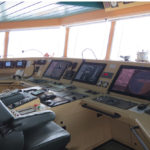Which technologies will make a difference in the maritime and energy sectors by the year 2020? DNV researchers may have found an answer.
In order to make predictions as accurate as possible, DNV identified seven »global megatrends« in its recent »Technology Outlook 2020[ds_preview]«, which, according to DNV, are all almost certain to occur, based on information provided by leading analysts on this topic:
1. • World population will grow past 7.5 billion people by 2020.
• The majority will live in cities.
• The demographic weight will shift towards developing regions, also due to aging populations in higher developed countries.
2. • BRIC countries may provide 50 % economic output of G7
countries.
• Global middleclass will grow up to 3.5 billion people.
3. • Governments have less power over their economies.
• Likely more protectionism will occur everywhere.
4. • Storage capacity will cost 1,000 times less in 2020, e.g. 1 TB
only costing 50 Cents.
• Mobile phones will have the processing power of modern PCs today.
5. • Energy consumption grows by 19 %, China taking the lead.
• 20 % of all energy will be renewable by 2020.
6. • Resources will become scarce, especially fresh water.
• Extreme weather will lead to more droughts etc. and thus to more starvation.
• Waste recycling is going to become a major industrial sector.
• Green house gas emissions will rise by 20 %, the sea level by 15 cm.
7. • The climate change goes on.
DNV has developed a system of different scenarios for the maritime and energy sectors (see diagram), depending on global economic growth and whether or not human society will actually take action and battle climate change:
Maritime
Expecting a world in which resource-intensive lifestyles become more and more widely spread and the population continues to increase, the maritime sector is almost certain to grow even further, as the demand for maritime transport will not stagnate before 2020. With growing gas-prices, social pressure for greener transportation, a sound economic base and upcoming political regulations, innovation in this sector is going to primarily concentrate on attacking energy losses and implementing green fuels.
There are several technologies that are possible candidates for this purpose. But only those that prove to be economically viable will be introduced.
An example for a technology tackling energy losses is, for instance, air bubble lubrication. By injecting micro air bubbles underneath the ship, it could be possible to reduce drag by up to 10–20 %. However, potentially negative interactions between the bubbles and the propeller still have to be excluded while solving several uncertainties regarding the scaling and technical feasibility of this system.
Concerning fuels, DNV considers almost every energy source known to us as thinkable, spanning from fossil energy to hybrid-models, fuel cells, or biofuels. Nevertheless, it regards especially LNG fuelling to have a very high chance of making a strong impact on the market. A large part of the necessary infrastructure for prolonged and steady LNG usage is expected to be erected by 2020.
Generally though, a shift toward more of an energy-mixture is foreseeable, making for a more efficient and more flexible world’s shipping fleet.
Oil, gas & coal
In 2020, according to DNV, the »big three« oil, gas and coal are still going to provide humanity with the largest part of its energy – 79 % of the global energy supply. Because of that, technological research in this field will concentrate on making extraction, as well as burning of these materials more efficient. Another large problem consists in making hardly accessible reservoirs of fossil energy exploitable.
As the demand for oil pushes the rigs further into deep waters and towards more complex reservoirs, DNV considers it highly probable that the development in the oil extraction industries will favour different, more specialized rig models. While complete subsea drilling and processing is a definite goal, it is very unlikely to be ripe for market implementation before very late in the 2020s.
According to recent, rather inprecise studies the global reserves in shale gas amount up to four times the size of the global conventional gas reserves. As Elisabeth Harstad, Managing Director DN Research and Innovation points out, shale gas might become a »real game changer«. Due to this, horizontal drilling is going to turn into a major innovation sector. Using this method, productivity may reach levels as much as 400 % higher than using conventional vertical drilling. The downside of exploiting earth’s shale gas reserves, however, is, similar to the downside of extracting oil from oil sands, massive environmental pollution. The process requires pumping large amounts of fresh water, chemicals and sand into the ground. Currently shale gas is only produced in the US, where the gas price has halved since the start of exploitation.
Renewables and nuclear
During the next decade, renewables will continue to gain ground compared to fossil energy sources, even though those are still going to dominate. The biggest challenges on this field are reducing costs and improving efficiency, all in order to be able to compete economically with fossil energies. Also, nuclear fission power plants will still be without competition in many countries of the world.
Every major renewable energy source was discussed in DNV’s technology outlook, pointing out technological advances in almost every thinkable field. Biofuels are believed to be a sustainable option for transport fuel, whereas solar, wind, or geothermal energy all have their specific advantages at producing electricity.
One major trend the DNV researchers believe to have identified is a switch in the design of onshore and offshore wind turbines. While offshore turbines will continue to increase in size, reaching capacities of 10 MW, onshore turbines have reached their maximum size due to transportation limits, according to DNV. However, both types will benefit from research put into the field of advanced control systems. These will, for instance, provide newly constructed turbines with the ability to pitch their blades in the correct angle in order to continuously maximize energy outputs.
Power systems
With more energy produced by renewable sources and their volatility in output a smarter power grid and energy storage solutions are essential. At certain times there will be an excess of energy, at other times there will be shortages. Therefore, DNV underlines the need of storage facilities, such as hydro power storage or compressed air energy storage. Furthermore, erecting a super grid and using high voltage direct current (HVDC) could allow transportation of energy from areas, where it is abundantly available, to areas experiencing energy shortages with minimal losses. Also, super grids allow much easier energy trading via large distances. It might become redundant to actually construct pipelines and the like, once a super grid is in place.
Looking at the big picture, a trend towards a more environmentally sustainable economy is identifiable. Increasing efficiency is the key in every single one of the four sectors DNV scrutinized, if the concerned enterprises want to stay economically competitive as well as operate within the ecological constraints state and society put upon them. As renewable energy sources will not be able to provide sufficient power and will still be lacking the reliability of fossil fuels, technologies that decrease CO2 emissions and improve efficiency of fossil power plants and engines will be the only way of limiting global warming to acceptable levels and dealing with high gas prices until 2020.





















